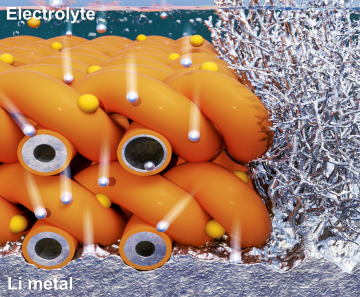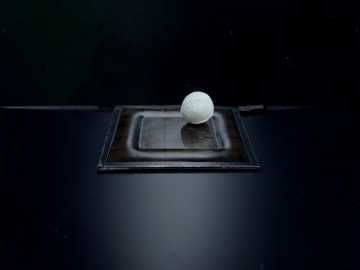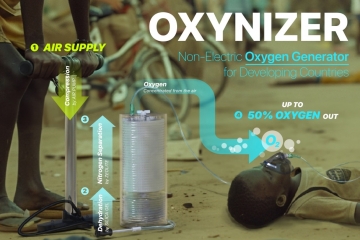KAIST
BREAKTHROUGHS
Research Webzine of the KAIST College of Engineering since 2014
Spring 2025 Vol. 24The rise of green electronics: high-performance and eco-friendly micro-supercapacitors on fallen leaves
The rise of green electronics: high-performance and eco-friendly micro-supercapacitors on fallen leaves
In recent years, electronic waste has become a major societal concern. Researchers have developed a new technology to produce high-performance and eco-friendly energy-storage devices on fallen leaves, paving the way for the next generation of green electronics.
Article | Fall 2022
The development of low-cost and eco-friendly energy storage devices is one of the greatest challenges of modern electronic devices due to their high levels of demand and shortened replacement cycles. Among energy storage devices, micro-supercapacitors (MSCs) have attracted much attention owing to the compact size, high power density, long lifespan, and short charging time. However, current MSCs are mainly produced from non-biodegradable synthetic polymers, resulting in massive amounts of electronic waste and environmental issues.
Forests cover one-third of land surfaces, making them one of the largest carbon feedstocks on Earth. Apart from providing high-value products such as food, wood, and medicinal compounds, forests also shed an enormous amount of leaves that normally turn into natural fertilizer. This natural biomaterial is completely biodegradable and renewable, making it a highly attractive and sustainable carbon resource. However, the excessive accumulation of fallen leaves in forests can turn into a fire hazard, resulting in the devastating destruction of homes, air pollution, and increasing global warming. Consequently, a new method to transform waste leaves into high-value-added products can have a significant impact on the sustainable development of our society.
To solve both problems at once, a research team led by Professor Young-Jin Kim from the Korea Advanced Institute of Science & Technology (KAIST) and Dr. Hana Yoon from the Korea Institute of Energy Research (KIER) has developed a novel technology that directly forms electrically conductive graphene microelectrodes on fallen leaves (Figure 1). Under the irradiation of femtosecond laser pulses, the organic compounds in the leaves are carbonized, graphitized, and exfoliated into laser-induced graphene (LIG) in ambient air. The resulting LIG microelectrodes exhibit outstanding and controllable electrical conductivity, offering valuable opportunities in diverse applications such as sensors, energy conversion and storage, and electrocatalysts. The researchers fabricated high-performance MSCs on leaves using this technology and demonstrated that MSCs on a single leaf could operate a light-emitting diode (LED) or a table clock easily (Figure 2).
The significance of this study is that it enables the use of cost-free, abundant, and renewable resources to produce high-performance green energy storage devices. The fabrication process is simple and does not require any additional materials or pre-treatments. Professor Young-Jin Kim said, “Leaves create forest biomass that comes in unmanageable quantities, so using them for next-generation energy storage devices makes it possible for us to reuse waste resources, thereby establishing a virtuous cycle.” Dr. Le, the first author of this paper, further emphasized, “Our breakthrough technology allows the direct fabrication of highly conductive LIG microelectrodes on a wide range of carbon materials, not just limited to fallen leaves. For instance, we have successfully converted cellulose papers and cotton fabrics into LIG. Undoubtedly, this one-step LIG synthesis and patterning technology can pave the way for the mass production of low-cost green electronics.”
This research was published and featured on the cover page of Advanced Functional Materials under the title “Green Flexible Graphene–Inorganic‐Hybrid Micro‐Supercapacitors Made of Fallen Leaves Enabled by Ultrafast Laser Pulses” and was also highlighted by various international media.
Further contact: Dr. Young-Jin Kim, Kwon Oh-Hyun Associate Professor, KAIST, Daejeon, Korea (yj.kim@kaist.ac.kr, +82-10-7613-2893).
Journal reference
Le, T.S.D., Lee, Y.A., Nam, H.K., Jang, K.Y., Yang, D., Kim, B., Yim, K., Kim, S.W., Yoon, H. and Kim, Y.J., Green Flexible Graphene–Inorganic‐Hybrid Micro‐Supercapacitors Made of Fallen Leaves Enabled by Ultrafast Laser Pulses. Advanced Functional Materials, 32.20 (2022): 2107768. DOI:10.1002/adfm.202107768
Most Popular

When and why do graph neural networks become powerful?
Read more
Smart Warnings: LLM-enabled personalized driver assistance
Read more
Extending the lifespan of next-generation lithium metal batteries with water
Read more
Professor Ki-Uk Kyung’s research team develops soft shape-morphing actuator capable of rapid 3D transformations
Read more
Oxynizer: Non-electric oxygen generator for developing countries
Read more

